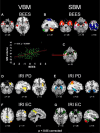The neurostructural bases of empathy: morphometric evidence for a multicomponential approach
- PMID: 40276066
- PMCID: PMC12018333
- DOI: 10.3389/fpsyt.2025.1544632
The neurostructural bases of empathy: morphometric evidence for a multicomponential approach
Abstract
The neural bases of individual differences in empathy subcomponents are still debated. We employed brain morphometry to investigate the neurostructural bases of individual and sex differences in specific empathy facets in 124 healthy individuals who completed the Balanced-Emotional-Empathy-Scale (BEES), and both the emotional/cognitive and self/other-oriented empathy subscales of the Interpersonal-Reactivity-Index (IRI). Univariate and multivariate morphometric analyses highlighted, respectively, voxels/clusters and whole structural networks where grey-matter volume reflected specific empathy subscores. Such morphometric properties were significantly related to individual differences in emotional empathy, while no evidence was found for structural networks underlying cognitive empathy. Personal distress correlated with grey-matter volume in the right insula and amygdala, likely mediating an affective sharing self-perceived as disturbing. Instead, empathic concern was associated with the medial precuneus and sensorimotor/inferior parietal cortex, possibly enabling empathic comprehension and prosocial behaviour mediated by attentional shift towards others. Female participants displayed larger grey-matter volume than male ones, related to higher emotional empathy, in limbic structures including amygdala and insula. These results ground multicomponential empathy models in specific neurostructural networks, representing a reference for future studies of empathic processing in health and disease.
Keywords: amygdala; brain morphometry; empathic concern; empathy; insula; intervention; personal distress; sex differences.
Copyright © 2025 Arioli, Rassouli Baghi, Cattaneo and Canessa.
Conflict of interest statement
The authors declare that the research was conducted in the absence of any commercial or financial relationships that could be construed as a potential conflict of interest. The author(s) declared that they were an editorial board member of Frontiers, at the time of submission. This had no impact on the peer review process and the final decision.
Figures




Similar articles
-
Inter-individual differences in empathy are reflected in human brain structure.Neuroimage. 2012 Sep;62(3):2034-9. doi: 10.1016/j.neuroimage.2012.05.081. Epub 2012 Jun 6. Neuroimage. 2012. PMID: 22683384 Free PMC article.
-
Deconstructing empathy: Neuroanatomical dissociations between affect sharing and prosocial motivation using a patient lesion model.Neuropsychologia. 2018 Jul 31;116(Pt A):126-135. doi: 10.1016/j.neuropsychologia.2017.02.010. Epub 2017 Feb 14. Neuropsychologia. 2018. PMID: 28209520 Free PMC article.
-
Sex difference in trait empathy is encoded in the human anterior insula.Cereb Cortex. 2023 Apr 25;33(9):5055-5065. doi: 10.1093/cercor/bhac398. Cereb Cortex. 2023. PMID: 36190444 Free PMC article.
-
Grey matter volume abnormalities in the first depressive episode of medication-naïve adult individuals: a systematic review of voxel based morphometric studies.Int J Psychiatry Clin Pract. 2021 Nov;25(4):407-420. doi: 10.1080/13651501.2020.1861632. Epub 2020 Dec 22. Int J Psychiatry Clin Pract. 2021. PMID: 33351672
-
Neural mechanisms, influencing factors and interventions in empathic pain.Neuropharmacology. 2025 May 15;269:110349. doi: 10.1016/j.neuropharm.2025.110349. Epub 2025 Feb 4. Neuropharmacology. 2025. PMID: 39914620 Review.
References
-
- Uzefovsky F, Knafo-Noam A. Empathy development throughout the life span. In: Social cognition. London, UK: Routledge; (2016). p. 89–115.
LinkOut - more resources
Full Text Sources

